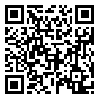Volume 20, Issue 4 (Winter 2026)
Salmand: Iranian Journal of Ageing 2026, 20(4): 500-513 |
Back to browse issues page
Download citation:
BibTeX | RIS | EndNote | Medlars | ProCite | Reference Manager | RefWorks
Send citation to:



BibTeX | RIS | EndNote | Medlars | ProCite | Reference Manager | RefWorks
Send citation to:
Aghaei N, Sadeghi R, Koosheshi M, Zeinab H E. A 100-year Projection of Population Aging in Iran Through the Decomposition of Population Momentum. Salmand: Iranian Journal of Ageing 2026; 20 (4) :500-513
URL: http://salmandj.uswr.ac.ir/article-1-2948-en.html
URL: http://salmandj.uswr.ac.ir/article-1-2948-en.html
1- Department of Demography, Faculty of Social Sciences, University of Tehran, Tehran, Iran.
2- Department of Demography, Faculty of Social Sciences, University of Tehran, Tehran, Iran. & National Institute of Population Research (NIPR),Ministry of Science, Research and Technology, Tehran, Iran. ,rassadeghi@ut.ac.ir
3- Department of Community Nutrition, Faculty of Nutrition and Food Industry, Shahid Beheshti University of Medical Sciences, Tehran, Iran.
2- Department of Demography, Faculty of Social Sciences, University of Tehran, Tehran, Iran. & National Institute of Population Research (NIPR),Ministry of Science, Research and Technology, Tehran, Iran. ,
3- Department of Community Nutrition, Faculty of Nutrition and Food Industry, Shahid Beheshti University of Medical Sciences, Tehran, Iran.
Abstract: (3277 Views)
Objectives In Iran, population aging is likely to continue with an increase in the number of older people in the upcoming decades. This study aims to provide a 100-year projection of Iran’s aging population by decomposing population momentum.
Methods & Materials This study uses data related to fertility and mortality estimates in Iran from 1996 to 2016. For a 100-year population projection, the cohort-component method was used in R software. The population momentum was calculated, and population aging trends over the study period were analyzed through age distribution.
Results The momentum of the Iranian population in 1996, 2006, 2011, and 2016 was positive, but its magnitude gradually decreased. The age-specific momentum analysis revealed that the highest values of momentum were related to the elderly population. According to the population projection, the elderly population of Iran, particularly influenced by population momentum, is expected to increase fourfold, and the aging index is projected to rise from approximately 25 in 2016 to 110 in 2061. However, this increasing trend of the elderly population will not continue beyond 2061, as momentum growth becomes zero and then negative due to low fertility rates.
Conclusion The positive values of population momentum are gradually declining. Despite the high rate of aging population in Iran, the country faces significant challenges in developing social policies for older adults. This situation requires Iranian policymakers to adopt necessary reforms in retirement, health, elderly care, and family-friendly policies.
Methods & Materials This study uses data related to fertility and mortality estimates in Iran from 1996 to 2016. For a 100-year population projection, the cohort-component method was used in R software. The population momentum was calculated, and population aging trends over the study period were analyzed through age distribution.
Results The momentum of the Iranian population in 1996, 2006, 2011, and 2016 was positive, but its magnitude gradually decreased. The age-specific momentum analysis revealed that the highest values of momentum were related to the elderly population. According to the population projection, the elderly population of Iran, particularly influenced by population momentum, is expected to increase fourfold, and the aging index is projected to rise from approximately 25 in 2016 to 110 in 2061. However, this increasing trend of the elderly population will not continue beyond 2061, as momentum growth becomes zero and then negative due to low fertility rates.
Conclusion The positive values of population momentum are gradually declining. Despite the high rate of aging population in Iran, the country faces significant challenges in developing social policies for older adults. This situation requires Iranian policymakers to adopt necessary reforms in retirement, health, elderly care, and family-friendly policies.
Type of Study: Research |
Subject:
Social
Received: 2024/10/04 | Accepted: 2024/12/28 | Published: 2026/03/01
Received: 2024/10/04 | Accepted: 2024/12/28 | Published: 2026/03/01
Send email to the article author
| Rights and permissions | |
 |
This work is licensed under a Creative Commons Attribution-NonCommercial 4.0 International License. |








